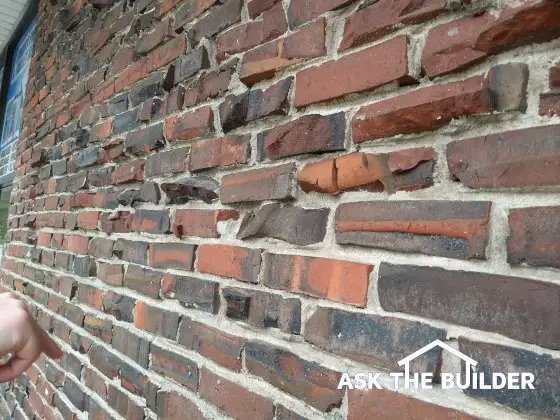Use Clinkers to Make Interesting Things & Concrete Crack Repair

These clinker brick create a unique appearance. Use them on houses and in gardens. (C) Copyright 2019 Tim Carter
Use Clinkers to Make Interesting Things
QUESTION #1: Timmy, I was on a tour of the Gamble house in Pasadena, CA and saw the most unusual deformed brick in a garden wall. The brick was twisted and looked more like random rocks than brick. I want some for my own house! How are clinker brick formed and where can I buy them? Are they durable and will they last a long time? Cindy H., Tucson, AZ
I saw the same clinker brick Cindy saw when I toured the stunning Gamble house about ten years ago. I don’t know if it was the architect or the Gambles themselves that specified the use of this unique building material, but it was genius. If you ever have the chance to tour this mansion, be sure to wander through the outdoor gardens to see the walls built with this strange brick.
Clinker brick are made just like any other brick. Brick start out as clay and are put into a kiln where the temperature of the clay is raised significantly. It’s important to realize that not all clay has the same chemical composition. As the temperature rises in the kiln, the clay actually softens and melts. This changes the internal structure of the clay such that it comes out of the kiln more like a rock than a soft material you can form with your hands.
Some brick in the kiln melt and deform. These are clinker brick. Keep in mind that the odd colors you sometimes see in brick, and especially clinkers, result from the small amount of oxygen in the kiln as the brick are heated.
The absence of oxygen almost always produces darker colors such as black and even blue. You can create all sorts of different colors depending on when you reintroduce oxygen as the brick start to cool. It’s all very complex, but the key point is that clinkers can be the most colorful and unusual brick you’ve ever seen.
Clinker brick, depending on the minerals in the clay, can be extremely durable. There are many factors, but realize some clinkers transform to a material much like glass if the clay happens to have a high silica content. The odds are clinker brick will perform quite well in just about all outdoor applications, including garden walls and outdoor pillars.
You purchase clinker brick at businesses that sell brick. Not all brick suppliers stock them, but you should have great luck ordering them as the brick manufacturers would rather sell clinkers than throw them away.
No matter where you use the clinker brick I recommend you spend some time thinking about the mortar that will be used in between each brick. I recommend creating a mortar blend that contains three parts Portland cement and one part hydrated lime. If you can source a special volcanic sand that’s high in silica, that would be ideal. Otherwise, use medium or loamy sand that’s very clean.
Concrete Crack Repair
QUESTION #2: Tim, my husband and I can’t agree on the best way to repair some cracks in our concrete. We have some long random cracks about 1/16th-inch wide in our garage and basement floors. This concrete has a smooth finish. My husband wants to squirt caulk into the cracks. I feel this will look like a scar on someone’s face. How would you repair these so they look good and the repair is durable? Monica, M., Waterloo, IA
Concrete crack repair is a very common problem. I receive questions like this each week. You may not be in a battle with your significant other like Monica, but you still want the cracks repaired and you probably want them to look great.
The first thing to realize is any repair you attempt may be temporary if the concrete is still moving or moves seasonally. I live in central New Hampshire and each winter the ground freezes. The frost in the ground causes concrete sidewalks, driveways, and patios to lift. If the lift is uneven, the cracks will reopen.
Interior concrete slabs like you find in a garage and basement are the easiest to repair and the concrete rarely moves. It’s important to realize if the concrete is brand new you’ll get shrinkage cracks as the concrete loses the extra water that was used when it was mixed. This shrinkage can take up to a year so don’t try to fix a new crack as it will most likely continue to widen as the months pass by.
Interior crack repair on smooth slabs can be done using regular unsanded ceramic tile grout. This works best for cracks 1/8 inch or narrower. Unsanded grout can be bought in different shades of gray to match your existing concrete color. Match the grout color by pouring a little bit of the dry powered grout on the concrete. The grout gets much darker once you add water, but it will dry the color it is straight from the bag.
I have a series of four videos at my AsktheBuilder.com website that shows the exact process of grouting floor tile. These videos show you how to achieve a perfect match when patching a crack in concrete. I recommend you watch them. The biggest mistake you can make is using the wrong tools to make the repair and pressing too hard when you wipe away the excess grout.
Column 1303